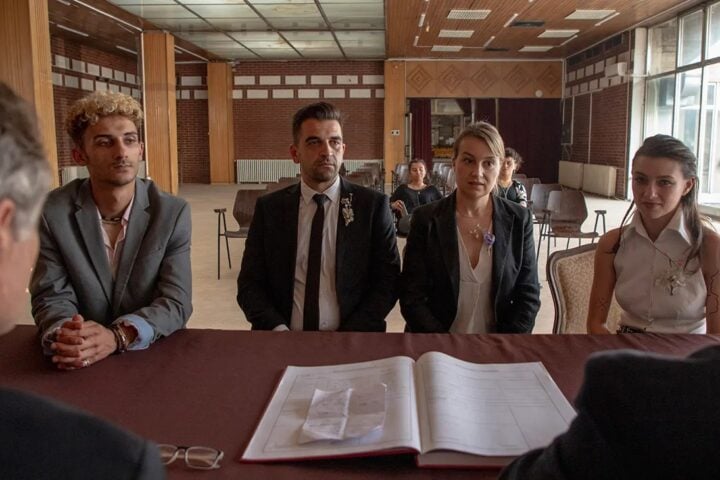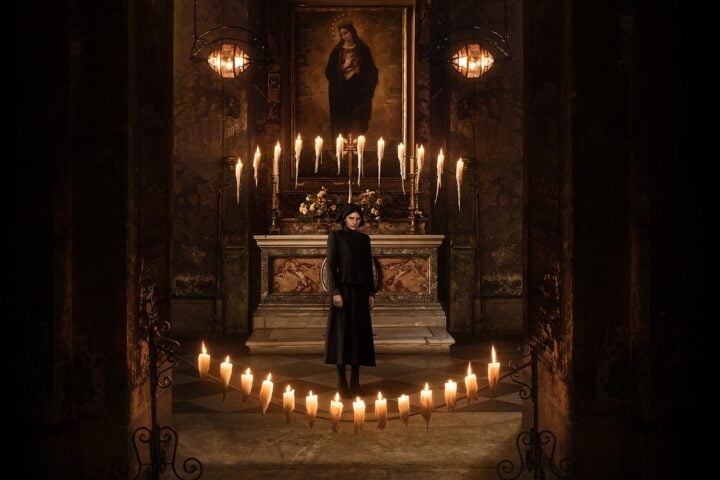Like so many of the comic-book supervillains that populate it, writer-director Vera Drew’s The People’s Joker arrives with an origin story. An “autobiographical transgender coming-of-age story,” the film stars Drew herself as Joker the Harlequin, an aspiring trans comedian who moves to a dystopic Gotham City and finds herself navigating both her own transition and the world of illicit underground comedy. The characters and settings are largely parodies drawn from DC Comics, but Warner Bros. wasn’t in on the joke, and after the film’s premiere at the Toronto International Film Festival back in 2022, the studio sent Drew a letter threatening legal action, and all future screenings were canceled.
After a long period of further delays and secret screenings of the film as Drew sought to make sure that she was fully protected from legal action under fair use has allowed for a fully legal release—complete with a thank-you to Warner Bros. for the free publicity. It’s the kind of backstory that might otherwise overshadow The People’s Joker completely, but the attempts to silence the film only reinforce its most salient ideas about the corporatization not just of art, but of the very terms of self-expression that art is supposed to foster.
Even without any foreknowledge of that, the intensely personal elements of The People’s Joker are unmistakable. Much of the story is recounted by Joker in direct address, beginning with her small-town childhood under the auspices of a narcissistic mother (Lynn Downey) who can only process young Joker’s cries for help as attacks on her own fitness as a parent (Joker’s deadname, used throughout this section, is hidden with a Kill Bill-style censor beep).
From there, Joker is prescribed the stopgap solution of Smylex, an antidepressant that forces her face into the character’s trademark rictus grin (“If I look happy, people ask fewer questions,” she heartbreakingly notes). She soon grows up and decides to pursue a career as a comedian in Gotham City, with the complication that all comedy outside of the late-night sketch show United Clown Bureau Live—an amalgam of the Upright Citizens Brigade and SNL headed by a computer-animated Lorne Michaels (Maria Bamford)—has been outlawed.
Throughout The People’s Joker, Drew lampoons comedy institutions as freely as she does superhero hegemony, in effect mounting an impassioned argument for the vitality of art made at the margins regardless of classification. UCB Live’s audition process is little more than a brain scan that determines whether potential performers are sufficiently desperate for approval, and the first episode we see features a Trumpian politician as guest host.
Drew’s previous career includes stints as an editor and VFX artist for Tim Heidecker and Eric Wareheim, and much of the film’s overstimulated digital-collage aesthetic and confrontational sense of humor feel of a piece with projects like On Cinema and Beef House. Joker gets around the ban on comedy by branding her underground troupe as “anti-comedy,” a phrase commonly applied to Heidecker’s work (Heidecker cameos as the voice of Daily Planet editor Perry White). On Cinema has likewise mined the DC villain’s one-size-fits-all anarchism for comedy before.
Principal photography on the film lasted only five days, mostly in front of green screens; according to Drew, VFX are present in every single shot. A panoply of effects artists and animators contributed independently in post-production, which is evident in the torrent of disparate ideas and styles that make up the film’s images. The strategy takes the film’s commentary on superhero cinema past the discursive level and into the aesthetic. On a fraction of the budget, Drew and her collaborators pack more inventive, handmade digital artistry into 90 minutes than can be found in the whole of the DCEU’s deadening CGI slop factory.
Drew diverges from her influences, though, by melding her satire with a surprisingly tender coming-out narrative. Joker’s first romantic partner after her transition—a transgender man, Mr. J (Kane Distler), styled after Jared Leto’s Joker—is derived from Drew’s own experiences. Drew has described Mr. J, an emotionally manipulative, wannabe-edgelord standup, in part as a rebuke to Leto’s infamous performance as a trans woman in Dallas Buyer’s Club. The co-opting of liberatory movements by rapacious capitalist interests is one of the film’s main satirical targets, and one that Warner Bros. quickly validated by undermining the film’s release.
Not everything in The People’s Joker works. For all its razor-sharp skewering of SNL, Drew’s film can share the show’s tendency to rely on well-trod Twitter discourse for humor, and there’s a natural disjointedness to its overall construction that can lessen its emotional impact. Still, more films could stand to offer an overload rather than a paucity of jokes and imagination, and The People’s Joker does so with an infectious underdog spirit.
Since 2001, we've brought you uncompromising, candid takes on the world of film, music, television, video games, theater, and more. Independently owned and operated publications like Slant have been hit hard in recent years, but we’re committed to keeping our content free and accessible—meaning no paywalls or fees.
If you like what we do, please consider subscribing to our Patreon or making a donation.




